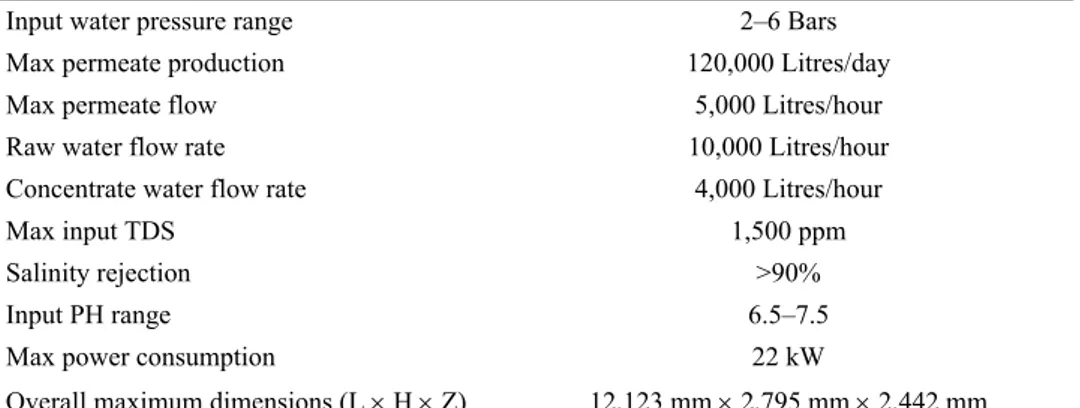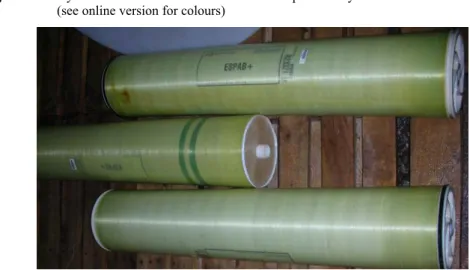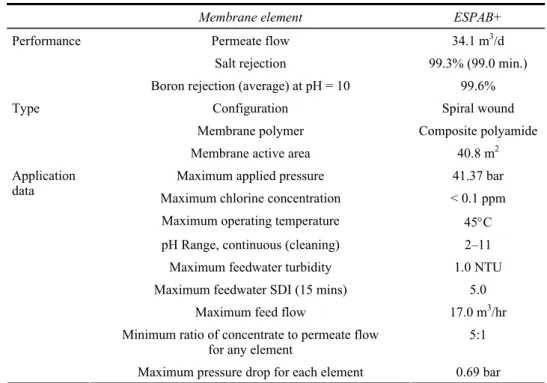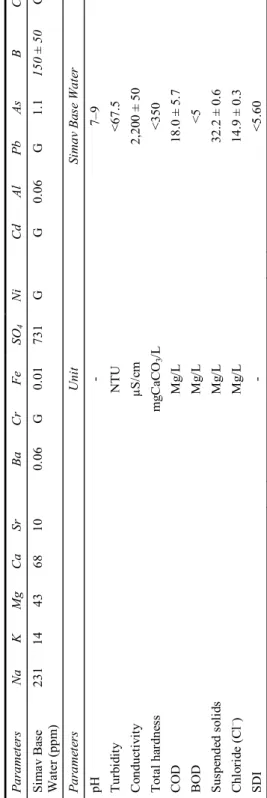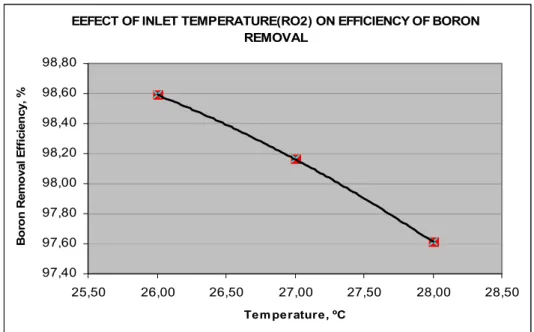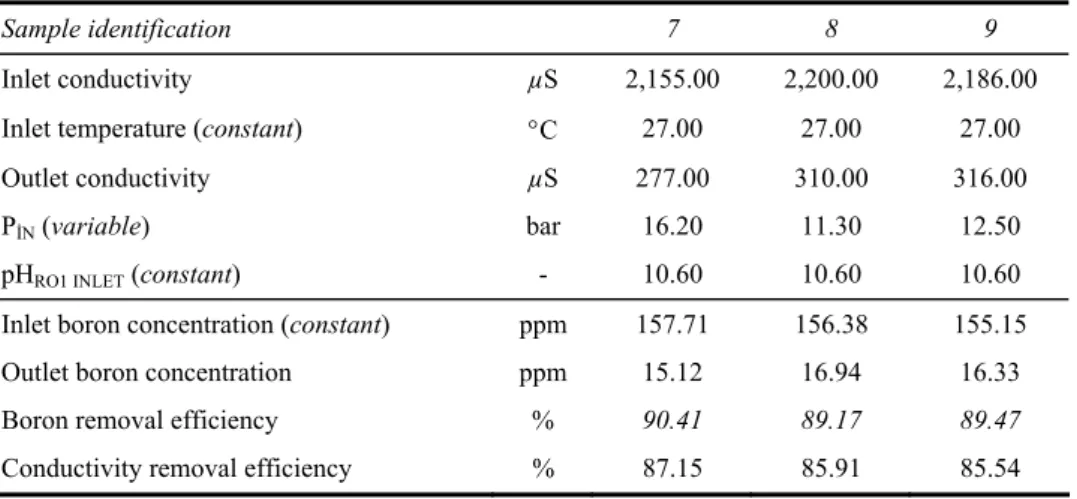2 authors:
Some of the authors of this publication are also working on these related projects:
The Status of Hydrogen in the Balance of Development-Energy-Environmental and Its Necessity of TurkeyView project
Mehmet Volkan Duman
South Marmara Development Agency
1PUBLICATION 2CITATIONS SEE PROFILE Elif Özmetin Balikesir University 8PUBLICATIONS 86CITATIONS SEE PROFILE
Boron removal from waste water originating in the
open pit mines of Bigadiç Boron Work by means of
reverse osmosis
Mehmet Volkan Duman* and Elif Özmetin
Department of Environmental Engineering, Cagis Campus, Balikesir University,
Bigadiç Road 17 km, 10145, Balikesir, Turkey E-mail: vduman@etimaden.gov.tr
E-mail: eozmetin@balikesir.edu.tr *Corresponding author
Abstract: In this study, the base water originating in Simav Open Pit Mine
containing the most important reserves of colemanite and ulexite boron minerals, has a boron concentration of 150 ± 50 mg/L, was treated to maximum 2 mg/L with the help of pilot RO system which was designed with two-phase reverse osmosis system. This system was designed and produced by Italian GEL Company. Temperature, pH, pressure and inlet boron concentration were chosen as research parameters in this study and influences of these parameters were analysed. According to the results of test periods; the efficiency of boron removal increases with increasing inlet pH and inlet pressure; the efficiency of boron removal decreases with increasing inlet temperature and inlet boron concentration. According to the economical analysis delivered during research
period, the cost of 1 m3 treated water is 1.21 € in 2010, the result for the year
2011 is 1.28 €. According to the cost analysis of the plant over years, energy and caustic consumptions took the biggest parts; it was concluded that the percentage of caustic consumption was 25.93 and the energy consumption was 22.11 in 2010; the percentage of caustic consumption is 21.92 and the energy consumption is 28.40 in 2011.
Keywords: boron removal; reverse osmosis; economical analysis; high pH
operation; open pit mine; waste water.
Reference to this paper should be made as follows: Duman, M.V. and
Özmetin, E. (2014) ‘Boron removal from waste water originating in the open pit mines of Bigadiç Boron Work by means of reverse osmosis’, Int. J. Global
Warming, Vol. 6, Nos. 2/3, pp.252–269.
Biographical notes: Mehmet Volkan Duman completed his BSc in Chemical
Engineering at Middle East Technical University and he completed his MSc in Environmental Engineering at Balikesir University. He has been working in Eti Mine Bigadiç Boron Work as Laboratory Manager for six years.
Elif Özmetin is one of the Assistant Professors of Environmental Engineering Department in Bahkesir University. She completed her BSc, MSc and PhD in Chemical Engineering at Erzurum Atatürk University. She is also performing the Management of Central Laboratory in Bahkesir University.
This paper is a revised and expanded version of a paper entitled ‘Boron removal from waste water originating from the open pit mines of Bigadiç Boron Work by means of reverse osmosis’ presented at the International Conference on Recycling and Reuse 2012 (R&R, 2012), Istanbul, Turkey, 4–6 June 2012.
1 Introduction
Recently, increasing activities in industrial developments may cause environmental problems and spoiling the equilibrium of life. Boron is biologically an essential nutrient for many plants but high boron concentrations in irrigation water cause toxic effects. Beside its toxic effects to the plants, also it can be considered as toxic to humans. Boron has been widely used in various manufacturing industries, and the level of boron in the industrial effluent can range from as high as several grams per litre to as low as a few milligrams per litre. Turkey is the leader in respect to total boron reserve with 67% of all the boron in the world in advance of USA and Russia (Eti Mine Works General Management Annual Report, 2008). Boron pit mines in Turkey have been managed by the State of Turkey so the government attaches importance to boron treatment especially for the sake of the regions where boron reserves are located. There are important studies concerning boron removal by utilising reverse osmosis both in Turkey and some other countries. Andreas Gorenflo et al. studied in the sea water reverse osmosis (SWRO) Plant, which was fully commissioned to produce low boron, desalinated water in 2005,
located in Ashkelon-Israel. The plant was designed to produce 330,000 m3/day of
drinking water which has boron concentration of <0.3 mg/L. The plant in Ashkelon was a good example for high pH operation (Gorenflo, 2006). Köseoglu and Kabay compared the removal of boron from their model solutions and seawater using two commercial high
rejection SWRO membranes: TorayTM UTC-80-AB and FilmtecTM SW30HR. In their
study, they determined the impacts of dissolved solids in seawater and pH on boron rejection (Köseoğlu, 2007). Maung Htun Oo and Lianfa Song concluded that more than 99% boron removal by RO membranes can be achieved at high pH, however it usually drops to 40%–80% at neutral pH (Oo, 2009).
All the boron deposits in Turkey are located in Western Anatolia. There are four production sites of boron mineral in the Northwestern of Anatolia; Bigadiç-Balıkesir, Emet-Kütahya, Kırka-Eskişehir and Kestelek-Bursa. All of the plants were founded near the boron pit mines except Bandırma boron work which is produced refined boron products and special products from the raw materials coming from the other four plants. Research and Development studies focus on the problems happening in Bandırma and Bigadiç plants. In Bandırma boron and acid works, all the waste water formed in different
processes is collected in a 30 m3 pool. The waste-water in the pool which is treated with
caustic lime, has a boron concentration of approximately 10 g/L. After coagulation process, calcium borate occurs as a precipitate which is sent to the pressed filters and
finally synthetic colemanite obtained. Synthetic colemanite which has 32%–35% B2O3, is
used as a raw material in boric acid plant. On the other hand treated water free of most of the boron content is sent to Marmara Sea. As a result 10 g/L boron concentration decreased under the limit of 500 ppm in the treated water.
Bigadiç Boron Work, which has the biggest reserves of colemanite, has an important place in mining industry. There are three open pit mines in Bigadiç Boron Work. In 2009, 800,000 of colemanite and ulexite which has approximately 29%–31% average boron content, is produced as excavated boron ore from these three open pit mines. By the end of the year 2009, 570 million tones colemanite and 49 million tones ulexite are located as boron ore reserve in Bigadiç which is a district of Balikesir. During excavation, underground water is collected in the base of the pit mine and this waste water must be disposed in order to continue mining. All the waste waters coming from the pit mines are collected in a nine million cubic meter dam. So this volume covers a huge area which is destructed and become unusable because of the boron toxicity. This problem is mostly caused by Simav Open Pit Mine which is the biggest one in Bigadiç Boron Work. Waste
water originating in Simav Open Pit Mine is approximately 120 m3/hr and the plan is to
keep clear of this waste water which has a boron concentration of 150 ± 50 ppm. In our
project pilot RO system which has a nominal capacity of 10 m3/hr (in terms of raw water
treatment) is used in order to remove boron from waste water. By using the variables such as pH, pressure, temperature and inlet boron concentration, efficiency of boron removal has been determined.
2 Materials and methods
This project was delivered with the help of pilot RO system which was designed on the basis of one of the advanced treatment type: reverse osmosis system, installed at the top of the Simav Open Pit Mine in Bigadiç Boron Work. Italian GEL Hydrotechnology Company designed and produced this pilot RO system mounted in a 40’ container. The specifications of the system are shown in Table 1.
Table 1 General specifications of pilot RO system
Input water pressure range 2–6 Bars
Max permeate production 120,000 Litres/day
Max permeate flow 5,000 Litres/hour
Raw water flow rate 10,000 Litres/hour
Concentrate water flow rate 4,000 Litres/hour
Max input TDS 1,500 ppm
Salinity rejection >90%
Input PH range 6.5–7.5
Max power consumption 22 kW
Overall maximum dimensions (L × H × Z) 12,123 mm × 2,795 mm × 2,442 mm
Boron mining and the production of concentrated and refined boron products are the processes which exist so much water and needs excessive water usage. Therefore, in boron industry, waste water must be controlled ideally. With this aspect, the basic aim of the foundation of this plant which is the first in boron treatment in Turkey has a mission to direct the research and development studies about waste water treatment in boron industry. In Figures 1 and 2, the description of the plant and flow sheet are shown in detail.
Figure 1 Hydranautics ESPAB+ membranes used in pilot RO system
(see online version for colours)
Figure 2 Dimensions of the membrane element
The plant has a pretreatment system and two reverse osmosis system. The pretreatment system contains; sand filter, carbon filter and water softening unit respectively. In the wake of pretreatment system, there are totally ten elements of 40-inch-hydranautics ESPAB+ membrane in two reverse osmosis system for boron treatment. The specifications of the ESPAB+ membrane element are shown in Table 2.
Table 2 Specifications of hydranautics ESPAB+ membrane
Membrane element ESPAB+
Permeate flow 34.1 m3/d
Salt rejection 99.3% (99.0 min.)
Performance
Boron rejection (average) at pH = 10 99.6%
Configuration Spiral wound
Membrane polymer Composite polyamide
Type
Membrane active area 40.8 m2
Maximum applied pressure 41.37 bar
Maximum chlorine concentration < 0.1 ppm
Maximum operating temperature 45°C
pH Range, continuous (cleaning) 2–11
Maximum feedwater turbidity 1.0 NTU
Maximum feedwater SDI (15 mins) 5.0
Maximum feed flow 17.0 m3/hr
Minimum ratio of concentrate to permeate flow
for any element 5:1
Application data
Maximum pressure drop for each element 0.69 bar
All membrane elements have brine seals and interconnectors. Elements are enclosed in a sealed polyethylene bag containing less than 1.0% sodium meta-bisulfite solution. The picture of the membranes are shown in Figure 1 and the lateral section with dimensions is shown in Figure 2.
The chemical composition of the raw water and other parameters belonging to raw water originating from Simav Open Pit Mine, are shown in Table 3. This waste water is used as a feed for the waste water treatment system. According to the flow sheet shown
in Figure 3, the raw water has a flow rate of 9 m3/hr. Before focusing on boron treatment,
calcium and magnesium concentration must be taken into consideration because of high-pH operation. If the hardness of the raw water is not treated, fouling on the surface of the reverse osmosis membranes increases the pressure and causes the system to stop.
So firstly, in sedimentation tanks, CaCO3 and Mg(OH)2 were precipitated by using
caustic soda, afterwards the raw water passes through sand filter, carbon filter and water softening unit respectively. Before entering microfiltration unit the hardness of the water is below 2 Fr. Except the operation conditions in some of the test runs, the inlet pH of the 1st reverse osmosis stage is above 10.00 and the inlet pH of the 2nd reverse osmosis stage is above 10.50 in order to obtain a product which has a boron concentration of maximum 2 ppm. The regulation legislated by Ministry of Environment and Forestry of Turkey (2004) says “boron concentration limits of the waste water which is discharged to the underground or surface water, is determined by the plants grown in that region if the water source is used for irrigation”. So according to this regulation boron treatment system in Bigadiç should decrease the boron concentration of the waste water under 2 ppm (Ministry of Environment and Forestry of Turkey, 2004). Lastly, treated water is sent to the Simav River at a pH of 6.5–8.5.
Table 3 Chemical and physical properties of raw water P ar ame te rs Na K M g Ca Sr Ba Cr Fe SO 4 Ni Cd Al P b As B Co Si m av Ba se W ater (p pm ) 23 1 1 4 43 68 10 0. 06 G 0. 01 73 1 G G 0. 06 G 1. 1 15 0 ± 50 G Pa ra m et er s Un it Si m av Ba se W at er pH - 7– 9 T urb id ity N T U < 67 .5 C ond uc ti vi ty µS/ cm 2, 20 0 ± 50 To ta l h ar dn es s mg Ca CO 3 /L < 350 C O D M g/ L 18 .0 ± 5 .7 BOD M g/ L <5 S usp en de d so li ds M g/ L 32 .2 ± 0 .6 Ch lo ri de ( C l – ) M g/ L 14 .9 ± 0 .3 SDI - < 5. 60
Figure 3 Flow sheet of boron treatment system in Bigadiç Boron Work (see online version for colours)
3 Results and discussion
If suitable values are set for the plant, the system produces high quality water which can be used as potable water. Therefore, the plan with a high-capacity-plant is to put treated water into service and will use the concentrate water originating from the waste water treatment plant to wash the boron ore in the concentrator plant located in Bigadiç Boron Work.
Table 4 Instantaneous parameters of pilot RO system
Instantaneous system parameters
µS Inlet conductivity 1,956.00
°C Inlet temperature 22.00
m3/hr Flowrate of raw water 9.38
bar Inlet pressure 17.30
- pHRO1 INLET (Inlet pH of R.O. Stage 1) 10.52
- pHRO2 INLET (Inlet pH of R.O. Stage 2) 11.00
ppm Inlet boron concentration 129.11
µS Outlet conductivity 13.00
ppm Outlet boron concentration 0.37
m3/hr Flowrate of treated water 5.52
% Efficiency of boron removal 99.71
% Instantaneous performance of the plant 58.85
The experiments were conducted with the help of the pilot plant, and the effects of pH, temperature, pressure and inlet boron concentration on efficiency of boron removal were observed. Efficiency of boron removal was calculated by the formulation below;
(
)
Efficiency of boron removal (%) 1 – C Cp f 100
⎡ = × ⎤
⎣ ⎦
In this formulation, Cf and Cp indicate boron concentration of raw water and treated water
produced, respectively. Pressure and pH can be adjusted by means of the control panel of the plant but temperature and inlet boron concentration are determined by the weather conditions, moreover inlet boron concentration is also affected by veins of ore. Each parameter mentioned above has changed or had different values while other parameters kept constant. So the effect on boron removal efficiency could be easily observed for each parameter and the different levels of boron concentrations have been evaluated with the help of the plant which has two separate reverse osmosis stages. For higher levels of boron concentration, the samples taken from the first stage were used and for lower levels of boron concentration, the samples taken from the second stage were used.
3.1 Effect of temperature for higher levels of boron concentration
Table 5 System parameters for temperature effect
Sample identification 1 2 3
Inlet conductivity µS 2,178.00 2,238.00 2,227.00
Inlet temperature (variable) °C 20.00 22.00 24.00
Outlet conductivity µS 97.00 250.00 285.00
PİN (constant) bar 10.00 9.80 10.00
pHRO1 Inlet (constant) - 10.26 10.25 10.25
Inlet boron concentration (constant) ppm 155.40 155.40 155.40
Outlet boron concentration ppm 14.48 18.45 20.59
Boron removal efficiency % 90.68 88.13 86.75
Figure 4 Effect of temperature on efficiency of boron removal (see online version for colours)
EFFECT OF INLET TEMPERATURE(RO1) ON EFFICIENCY OF BORON REMOVAL 86,50 87,00 87,50 88,00 88,50 89,00 89,50 90,00 90,50 91,00 19,0 20,0 21,0 22,0 23,0 24,0 25,0 Tem perature,ºC B o ro n R em o val E ff ici en cy, %
Table 6 System parameters for temperature effect
Sample identification 4 5 6
Inlet conductivity µS 316.00 338.00 324.00
Inlet temperature (variable) °C 28.00 27.00 26.00
Outlet conductivity µS 44.00 46.00 45.00
PİN (constant) bar 7.00 7.00 7.00
pHRO2 INLET (constant) - 10.80 10.80 10.80
Inlet boron concentration (constant) ppm 16.33 16.33 16.33
Outlet boron concentration ppm 0.39 0.30 0.23
Boron removal efficiency % 97.61 98.16 98.59
Figure 5 Effect of temperature on efficiency of boron removal (see online version for colours)
EEFECT OF INLET TEMPERATURE(RO2) ON EFFICIENCY OF BORON REMOVAL 97,40 97,60 97,80 98,00 98,20 98,40 98,60 98,80 25,50 26,00 26,50 27,00 27,50 28,00 28,50 Tem perature, ºC Bo ro n Remo val E ff ici en cy, %
3.2 Effect of temperature for lower levels of boron concentration
In the process, temperature was not under control, moreover weather condition was the only factor that determined the temperature. According to the system parameters in Tables 4 and 5, temperature vs. boron removal efficiency graphs were plotted. Figures 3 and 4 indicate that when the temperature increases, the boron removal efficiency decreases. The rate of water permeation through the membrane increase as the feed water temperature increases since the viscosity of the solution is reduced and higher diffusion rate of water through the membrane is obtained (Al-Mutaz and Al-Ghunaimi, 2001). Temperature increment caused low quality water and it will yield lower boron rejection. Higher boron passage is due to higher diffusion rate for boron through the membrane. Gluckstern and Priel (2003) stated in their study that Mekorot the Israeli company verified the reduction of boron removal efficiency in the case of temperature rising between the pH values 6.8–8.0 during the test periods. In the study of Mekorot; when the flux was 15.6 lmh and pH was 8.0 at 25°C boron removal efficiency was calculated as to be 89.9%, in the case of 30°C with same values of other parameters, boron removal efficiency was found 87.3% (Gluckstern and Priel, 2003).
3.3 Effect of pressure for higher levels of boron concentration
Table 7 System parameters for pressure effect
Sample identification 7 8 9
Inlet conductivity µS 2,155.00 2,200.00 2,186.00
Inlet temperature (constant) °C 27.00 27.00 27.00
Outlet conductivity µS 277.00 310.00 316.00
PİN (variable) bar 16.20 11.30 12.50
pHRO1 INLET (constant) - 10.60 10.60 10.60
Inlet boron concentration (constant) ppm 157.71 156.38 155.15
Outlet boron concentration ppm 15.12 16.94 16.33
Boron removal efficiency % 90.41 89.17 89.47
Conductivity removal efficiency % 87.15 85.91 85.54
Figure 6 Effect of pressure on efficiency of boron removal (see online version for colours) EFFECT OF INLET PRESSURE (RO1) ON EFFICIENCY OF BORON
REMOVAL 89,00 89,20 89,40 89,60 89,80 90,00 90,20 90,40 90,60 11,00 12,00 13,00 14,00 15,00 16,00 17,00 Pressure, bar B o ro n R em o val E ff ici en cy, %
Table 8 System parameters for pressure effect
Sample identification 10 11 12
Inlet conductivity µS 80.00 125.00 126.00
Inlet temperature (constant) °C 19.00 19.00 19.00
Outlet conductivity µS 7.00 17.00 17.00
PİN (variable) bar 9.00 10.00 9.50
pHRO1 INLET (constant) - 10.60 10.60 10.60
Inlet boron concentration (constant) ppm 7.79 10.97 8.43
Outlet boron concentration ppm 0.34 0.14 0.27
Boron removal efficiency % 95.64 98.72 96.80
Conductivity removal efficiency % 91.25 86.40 86.51
Figure 7 Effect of pressure on efficiency of boron removal (see online version for colours)
3.4 Effect of pressure for lower levels of boron concentration
During test periods in the plant, inlet pressure was adjusted with the help of inverter situated on the control panel. According to the system parameters in Tables 6 and 7, pressure vs. boron removal efficiency graphs were plotted. Figures 5 and 6 indicate that when the pressure is increased, boron removal efficiency also increases. The increment of driving-force on the membranes caused to increase the flow rate of permeate and provide higher quantity of treated water passing through the membranes in unit time. This pressure effect which brings about dilution of treated water, is the reason for reduction of boron content in treated water. With pressure increment compaction effect also has a role in removal process of boron. But upon a certain value, pressure increment did not enable a serious rejection of boron so the pressures of the membrane pumps must be optimised
in order to operate the system economically. Prats et al. (2000) analysed the influences of pH and pressure. They concluded that boron removal efficiency increased when the pressure increased (Prats et al., 2000). Pinhas Gluckstern and Menahem Priel reported a study which is delivered by Mekorot in 2003. According to the results of Mekorot; for a pH-neutral raw water at 25°C when the flux was 12.6 lmh boron removal efficiency was 85.3% and when the flux was 15.6 lmh boron removal efficiency was 88.6%; for a pH-neutral at 30°C when the flux was 12.6 lmh boron removal efficiency was 83.7% and when the flux was 15.6 lmh boron removal efficiency was 86.3% (Gluckstern and Priel, 2003).
3.5 Effect of higher inlet boron concentration
Table 9 System parameters for inlet boron concentration effect
Sample identification 13 14 15
Inlet conductivity µS 2,123.00 2,186.00 2,125.00
Inlet temperature (constant) °C 27.00 27.00 27.00
Outlet conductivity µS 185.00 316.00 295.00
PİN (constant) bar 13.00 13.00 13.00
pHRO1 INLET (constant) - 10.60 10.60 10.60
Inlet boron concentration (variable) ppm 144.70 155.15 151.75
Outlet boron concentration ppm 13.70 16.33 15.23
Boron removal efficiency % 90.53 89.47 89.96
Conductivity removal efficiency % 91.29 85.54 86.12
Figure 8 Effect of inlet boron concentration on efficiency of boron removal
(see online version for colours)
EFFECT OF INLET BORON CONCENTRATION(RO1) ON EFFICIENCY OF BORON REMOVAL 89,4 89,6 89,8 90 90,2 90,4 90,6 144 146 148 150 152 154 156
Inlet Boron Concentration,ppm
B o ro n R em o val E ff ic ien cy, %
3.6 Effect of lower inlet boron concentration
Table 10 System parameters for inlet boron concentration effect
Sample identification 16 17 18
Inlet conductivity µS 347.00 339.00 328.00
Inlet temperature (constant) °C 28.00 28.00 28.00
Outlet conductivity µS 54.00 56.00 58.00
PİN (constant) bar 7.00 7.00 7.00
pHRO1 INLET (constant) - 10.60 10.60 10.60
Inlet boron concentration (variable) ppm 20.69 17.42 15.89
Outlet boron concentration ppm 1.48 0.82 0.62
Boron removal efficiency % 92.85 95.29 96.10
Conductivity removal efficiency % 84.44 83.48 82.32
Figure 9 Effect of inlet boron concentration on efficiency of boron removal
(see online version for colours)
In the process, inlet boron concentration were determined by the weather conditions, moreover inlet boron concentration is also affected by veins of ore in Simav Open Pit Mine. In that region there are 20,250,000 tons of colemanite and 7,600,000 tons of ulexite which is ready for mining. Ulexite is more soluble in water than colemanite and also there are some other boron minerals in the pit mine which have different water solubilities. According to the system parameters in Tables 8 and 9, inlet boron concentration vs. boron removal efficiency graphs were plotted. Figure 7 and Figure 8 indicate that when inlet boron concentration increased, boron removal efficiency decreases.
3.7 Effect of ph for higher levels of boron concentration
Table 11 System parameters for pH effect
Sample identification 19 20 21 22
Inlet conductivity µS 2,211.00 2,244.00 2,244.00 2,244.00
Inlet temperature (constant) °C 25.00 25.00 25.00 25.00
Outlet conductivity µS 416.00 416.00 408.00 291.00
PİN (constant) bar 13.10 13.10 13.10 13.10
pHRO1 INLET (variable) - 10.00 10.10 10.20 10.40
Inlet boron concentration (constant) ppm 146.12 146.12 146.12 146.12
Outlet boron concentration ppm 33.08 29.22 25.92 17.50
Boron removal efficiency % 77.36 80.00 82.26 88.02
Conductivity removal efficiency % 81.18 81.46 81.82 87.03
Figure 10 Effect of pH on efficiency of boron removal (see online version for colours)
EFFECT OF INLET pH(RO1) ON EFFICIENCY OF BORON REMOVAL
76,00 78,00 80,00 82,00 84,00 86,00 88,00 90,00 9,80 9,90 10,00 10,10 10,20 10,30 10,40 10,50 10,60 Inlet pH Bo ro n Re m o va l E ff ici en cy , %
3.8 Effect of ph for lower levels of boron concentration
Table 12 System parameters for pH effect
Sample identification 23 24 25
Inlet conductivity µS 185.00 292.00 338.00
Inlet temperature (constant) °C 27.00 27.00 27.00
Outlet conductivity µS 19.00 43.00 46.00
PİN (constant) bar 7.00 7.00 7.00
Table 12 System parameters for pH effect (continued)
Sample identification 23 24 25
Inlet boron concentration (constant) ppm 13.70 13.50 13.07
Outlet boron concentration ppm 0.94 0.49 0.25
Boron removal efficiency % 93.14 96.37 98.09
Conductivity removal efficiency % 89.73 85.27 86.39
Figure 11 Effect of pH on efficiency of boron removal (see online version for colours)
According to the results of analysed samples taken during the operation of plant; the efficiency of boron removal increases with increasing inlet pH and inlet pressure; the efficiency of boron removal decreases with increasing inlet temperature and inlet boron concentration. Considering the results of the test periods, it was certainly seen that pH had a great effect on boron removal.
Boron exists as non-ionic boric acid form in water at neutral pH values. The structure of the molecule is planar as it is seen in Figure 11 and it is neutral so boric acid easily pass the membranes. When pH is increased, borate anions form in the solution towards the reaction (http://en.wikipedia.org/wiki/Boric_acid):
3 2 4
B(OH) H O + ↔ B(OH) −+ H+
This anion seen in Figure 12, has a tetrahedral structure and it is a charged particle so borate anion was easily removed by the membranes. When the boron concentration increases and pH values is getting higher by adding caustic soda, tetraborate anions form in the solution towards the reaction:
2–
3 3 4 7 2
These polyborates are bulky units and charged particles so this is a big advantage in removal process by membranes. So caustic consumption took the biggest part in both years 2010 and 2011.
Figure 12 Non-ionic boric acid molecule (see online version for colours)
Source: http://en.wikipedia.org/wiki/Boric_acid
Figure 13 Borate ion (see online version for colours)
Source: (http://en.wikipedia.org/wiki/Borate#Aqueous_chemistry)
4 Conclusions
This research showed us that waste water problem of Bigadiç Boron Work can be solved by treating of ground water originating in Simav Open Pit Mine, with the help of reverse osmosis system. The plan is to discharge the treated water which has a boron concentration of under 2 mg/L, to the Simav River located near the Pit Mines. Pressure, temperature, inlet boron concentration and pH are the research parameters in our study. According to the results of test periods; the efficiency of boron removal increases with increasing inlet pH and inlet pressure; the efficiency of boron removal decreases with increasing inlet temperature and inlet boron concentration. The results showed us that especially variation of pH has a deep effect on boron removal efficiency. During research period, the average boron concentration of inlet raw water was calculated as 142.25 mg/L. Under normal operating conditions determined for the pilot plant (T1, T2 = 20°C and P1 = 10 bar, P2 = 8 bar) if the inlet pH of 1st RO stage was above 10.00 and the inlet pH of 2nd RO stage was above 10.50, boron removal efficiency went up above
99%. An economical analysis was reported for each month by taking the chemicals usage, consumables except chemicals and energy consumption into consideration. As a result of these reports, the cost of the treated water without labour cost was calculated as
to be 1.21 €/m3 in 2010 and the result for the year 2011 was determined 1.28 €/m3.
References
Al-Mutaz, I.S. and Al-Ghunaimi, M.A. (2001) ‘Performance of Reverse osmosis at high temperatures’, Paper presented at the IDA World Congress. Bahrain: Desalination and Water
Reuse, 26–31 October.
Eti Mine Works General Management Annual Report (2008) [online]
http://www.etimaden.gov.tr/d/file/2008yili_faaliyetraporu.pdf (accessed 20 September 2010). GEL Hydrotechnology (2009) Boron Treatment System, pp.21–22, Ancona, Italy.
Glueckstern, P. and Priel, M. (2003) ‘Optimization of boron removal in old and new SWRO systems’, Desalination, Vol. 156, Nos. 1–3, pp.219–228.
Gorenflo, A. (2006) ‘High pH operation in seawater RO permeate: first results from the world’s largest SWRO plant in Ashkelon’, Desalination, Vol. 203, Nos. 1–3, pp.82–90.
Köseoglu, H. (2007) ‘The removal of boron from model solutions and seawater using SWRO membranes’, Desalination, Vol. 223, Nos. 1–3, pp.126–133.
Ministry of Environment and Forestry of Turkey (2004) The Guideline of Water Pollution Control, (official journal: 25687), December 12.
Oo, M.H. (2009) ‘Effect of pH and ionic strength on boron removal by RO membranes’,
Desalination, Vol. 246, Nos. 1–3, pp.605–612.
Prats, D., Chillon-Arias, M.F. and Pastor, M. (2000) ‘Analysis of the influence pH and pressure on the elimination of boron in reverse osmosis’, Desalination, Vol. 128, No. 3, pp.269–273. Wikipedia Foundation, Inc., Borate [online]
http://en.wikipedia.org/wiki/Borate#Aqueous_chemistry (accessed 22 July 2010). Wikipedia Foundation, Inc., Boric Acid [online] http://en.wikipedia.org/wiki/Boric_acid
